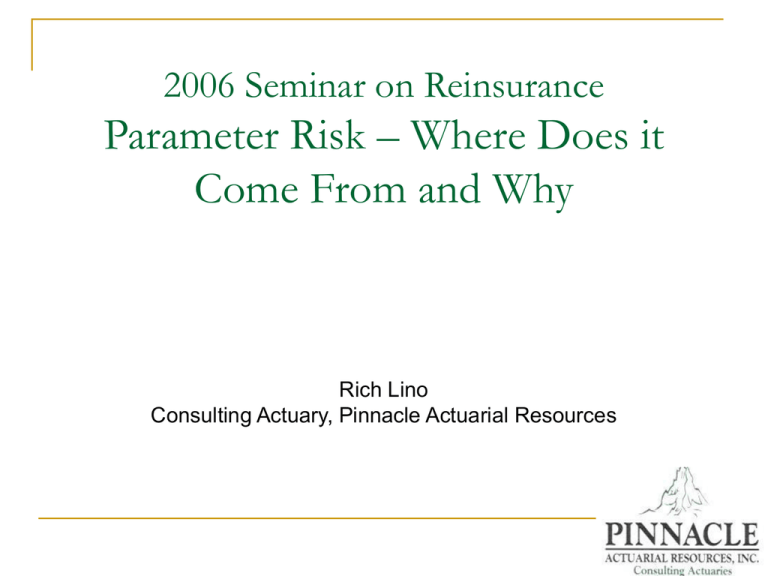Parameter Risk – Where Does it Come From and Why Rich Lino
advertisement

2006 Seminar on Reinsurance Parameter Risk – Where Does it Come From and Why Rich Lino Consulting Actuary, Pinnacle Actuarial Resources Sources of Parameter Risk Catastrophe exposure Pricing Loss development Changes in business mix Other changes in parameter risk Actions to mitigate parameter risk Catastrophe Risk Accuracy of exposure data Weather cycles: 2006 predictions are for 150% to 200% of last century average (ISODr. Gray) Model revisions Impact of growth in exposed areas Earthquake below long-term average? PCS Loss To Property Direct WP 18% 16% 14% 12% 10% 8% 6% 4% 2% 0% ` 19731988 19891996 19972005 19732005 Source: ISO-PCS for Cat; AM Best for DWP Pricing Average price level change Impact of changes in terms/conditions/limits Miscoding of class, tier, E&S Vs. Standard Lines Price monitor for new business Changes in mix of business Winner’s Curse Direct Writtten Premium - Property to Nominal GDP 1.00% 0.95% 0.90% 0.85% 0.80% 0.75% 0.70% 0.65% Source: AM Best DWP; Property Estimated; BEA GDP 20 05 20 03 20 01 19 99 19 97 19 95 19 93 19 91 19 89 19 87 19 85 19 83 19 81 19 79 19 77 19 75 19 73 0.60% CMP Accident Year Net Ultimate Loss and ALAE Ratio (LHS). Direct Earned Premium and AY Loss Amount to GDP (Right Scale). 150% 4.50 4.00 3.50 3.00 2.50 2.00 1.50 1.00 0.50 - Loss Ratio 125% 100% 75% 50% 1975 1980 1985 1990 1995 Years Loss Ratio CY DEP AY Loss 2000 Per $1,000 GDP Source: AM Best and Pinnacle Estimates Loss Development Cycle- Reserve weakening, payment slowdown will bias ultimates on the low side in soft markets and vice versa Variations by Company – Base, Cycle Variations by Layer Changes in terms/conditions/limits can affect development Industry Aggregate-Med Mal Total Ultimate Using "LDFs As Of Y/E" Vs. 2004 Estimate of Ultimate Data As Of Incurred LDFs Year-End AY x AY x-1 AY x-2 1996 85% 96% 98% 1997 86% 88% 92% 1998 81% 86% 88% 1999 80% 83% 88% 2000 87% 91% 89% 2001 94% 98% 99% Mean 85% 90% 92% Changes in Business Mix Prices declining, more exposure per premium dollar More adverse winner’s curse causes lower retention Lower retention means more new business per premium dollar Severe winner’s curse on new business Failure to adjust creates parameter risk Drivers of Parameter Risk - WC Base 1997-2000 2000-2003 Base Price Vs. Exposure 0% -4% 6% Tiers/Schedule Rating 0% -10% 9% R/N Retention 80% 86% 82% R/N Quality 97% 98% 92% New Business % 20% 35% 15% New Quality Vs. Renewal 115% 130% 118% Parameter Risk From Reinsurer’s Perspective Other Potential For Parameter Risk Offering limits not previously available Value of information not provided (cyclical) Buy downs of limit – asymmetric information Self-insurers moving in and out of the market Impact of acquisitions on pricing assumptions Cycle of ISO/NCCI pricing adequacy MGA cycle Optimism/pessimism cycle Other Potential For Parameter Risk, cont’d Multi-year policies – direct and assumed Loosening terms and conditions Loosening underwriting standards Adverse selection as top tier companies refine rating structures Impact of changing mix of TPAs Beware high growth and “fighting claims” Actions to mitigate parameter risk Measure all aspects of price change Monitor industry and client reserve adequacy Monitor total change in industry price & L/R Focus audits on new business Model impact of winner’s curse in soft market Pursue identification of turning points Set data quality standards and keep them Refine pricing by account Source: Pinnacle calculations from AM Best data base


